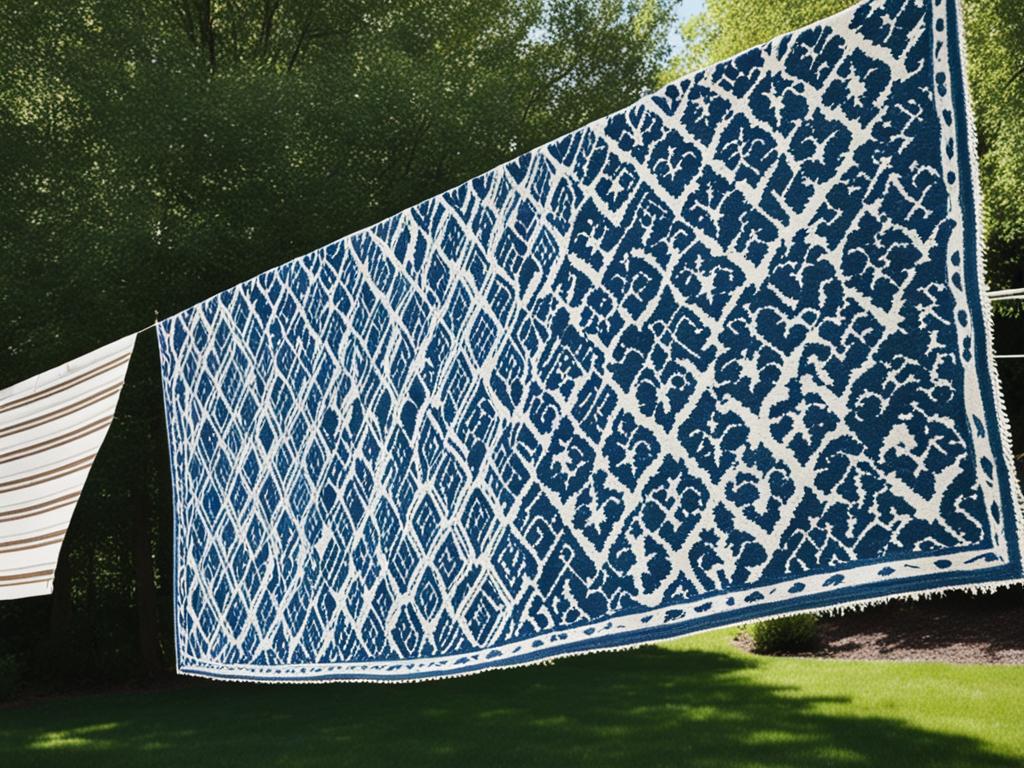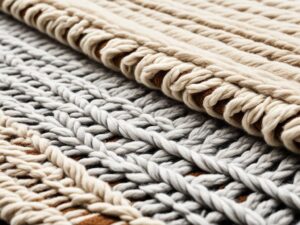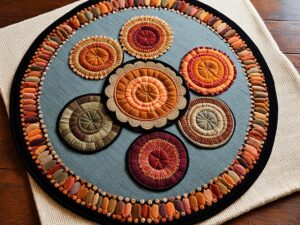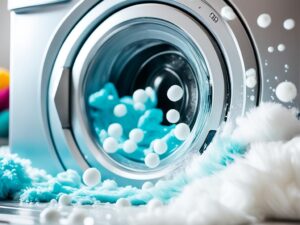Properly drying an area rug is essential to maintain its quality and prevent mold, mildew, and unpleasant odors. Whether your rug has been affected by a spill, flood, or excess humidity, it’s important to know the best techniques for drying it effectively. In this guide, we will walk you through the steps and offer quick tips on how to dry an area rug with ease.
Key Takeaways:
- Removing excess water is the first step in drying an area rug, and it can be done by towel blotting, using absorbent materials, or a wet-dry vacuum.
- There are various rug drying methods, including air drying, hanging the rug outside, using fans, and avoiding direct sunlight.
- Disinfecting and deodorizing the rug after drying is crucial, and rubbing alcohol can be used for synthetic rugs.
- Pressure washing can be effective for cleaning rugs, but proper drying is essential to prevent mold and mildew growth.
- When pressure washing a rug, use appropriate techniques and avoid high-pressure settings on delicate fabrics.
Remove Excess Water
The first step in drying an area rug is to remove excess water. This is crucial to prevent further damage and speed up the drying process.
There are several methods you can use to remove excess water from the rug:
- Towel Blotting: Start by laying absorbent towels on the wet rug. Gently press down and blot the surface to soak up the water. Repeat this process with dry towels until no more water is being absorbed.
- Wringing Out Water: If the rug is smaller and easily maneuverable, you can try wringing out the water by twisting the rug in opposite directions. Be careful not to damage the rug fibers.
- Using Absorbent Materials: Another option is to place absorbent materials, such as paper towels or cloth, on top of the wet rug. Press down firmly to encourage water absorption. You can even jump on the towels to extract more water.
- Using Kitty Litter: For larger rugs, consider placing a layer of kitty litter between the rug and towels. The kitty litter acts as a highly absorbent material and helps in faster water absorption.
- Wet-Dry Vacuum: If you have access to a wet-dry vacuum, use it to suck out the water from the rug. Ensure that the vacuum is set to the appropriate mode and gently move it over the surface of the rug.
Using any of these methods will help eliminate the excess water from the rug, preparing it for the next steps in the drying process.
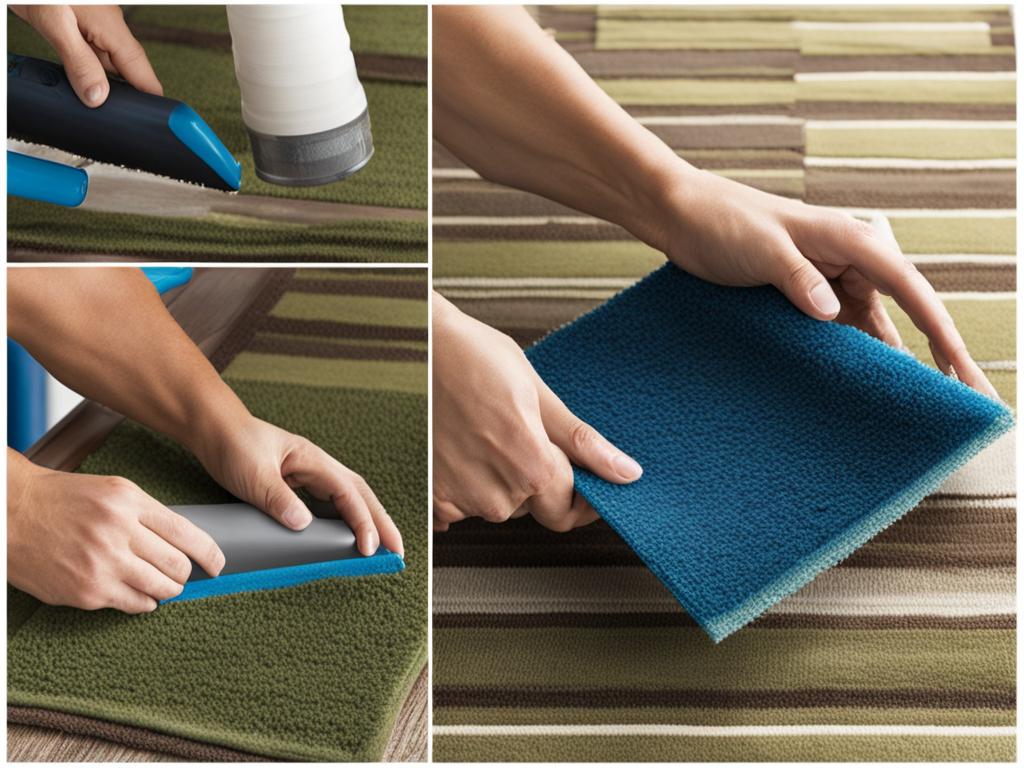
Rug Drying Methods
When it comes to drying an area rug, there are several methods you can use to ensure efficient drying and prevent any potential damage. Whether you’re dealing with a small rug or a larger one, it’s essential to choose the right drying technique. Here are some effective rug drying methods to consider:
Hanging Rug Outside
If the weather permits, hanging your rug outside in a warm, sunny spot can be the best option for air drying. This method allows for natural airflow and helps expedite the drying process. For smaller rugs, you can use clothespins or clips to secure them to a clothesline. Larger rugs may require an over-the-line rack system to provide ample space for drying.
Using Fans
If you need to dry the rug indoors or if the weather isn’t suitable for outdoor drying, using fans can be a great alternative. Place fans strategically around the rug to ensure proper airflow and ventilation. It’s important to prop up the rug with heavy objects, such as books or furniture, to prevent it from curling or warping during the drying process.
Avoiding Direct Sunlight
While sunlight can help in drying certain types of materials, it’s essential to avoid direct sunlight when drying rugs, especially delicate ones. Direct sunlight can cause fading or discoloration, and may weaken the rug fibers. Instead, choose a shaded area for drying or use curtains to filter the sunlight if drying indoors.
Drying Racks
If you don’t have the option to hang your rug outside or use a clothesline, drying racks can be a convenient alternative. These racks offer a flat and even surface for the rug to dry on. Ensure that the rug is properly supported on the drying rack to maintain its shape and prevent any stretching or distortion.
Drying Wet Padding
In addition to drying the rug itself, it’s crucial to address any wet padding underneath. Wet padding can lead to mold and mildew growth if not properly dried. Remove the wet padding and allow it to air dry separately before reapplying it to the rug.
By following these rug drying methods, you can effectively dry your area rug and prevent any potential damage. Remember to choose the method that suits your situation and rug type, and always prioritize proper airflow and gentle handling during the drying process.
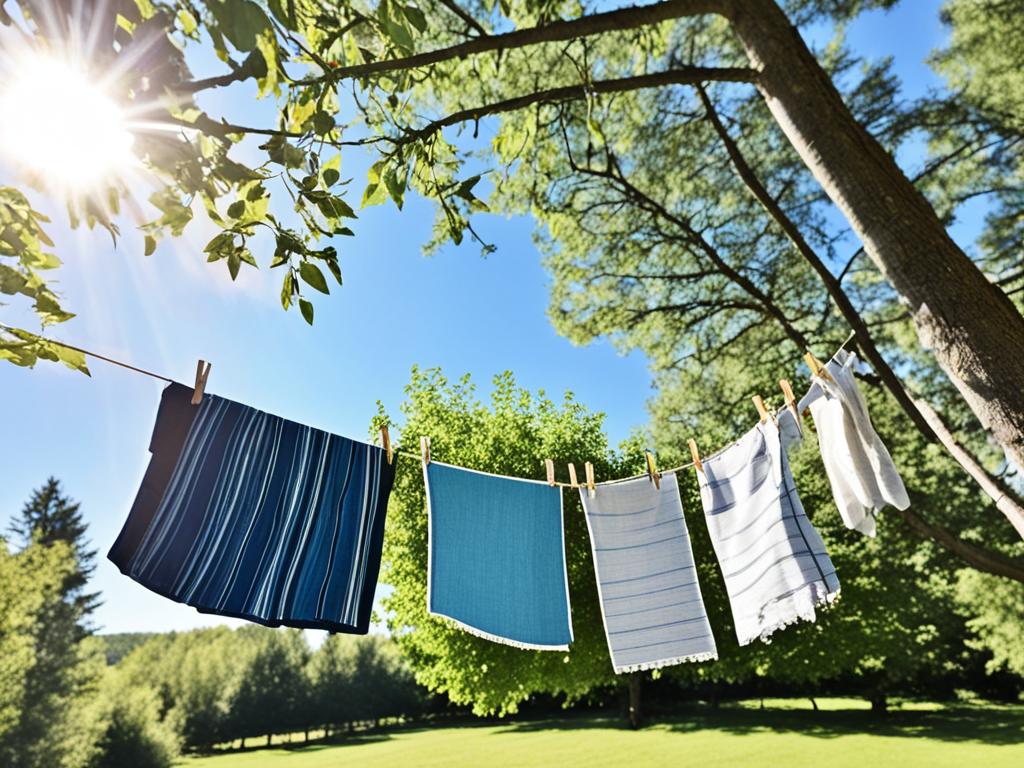
Disinfect and Deodorize
Once the rug is thoroughly dry, the next step is to disinfect and deodorize it to ensure a clean and fresh-smelling result. Disinfecting the rug helps eliminate any lingering bacteria or germs, while deodorizing removes unpleasant odors.
Using Rubbing Alcohol
For synthetic rugs, rubbing alcohol is an effective disinfectant and deodorizer. Simply fill a spray bottle with rubbing alcohol and spritz all sides of the rug. Make sure to cover the entire surface evenly. Rubbing alcohol will kill bacteria and remove odors without causing any damage to the rug fibers.
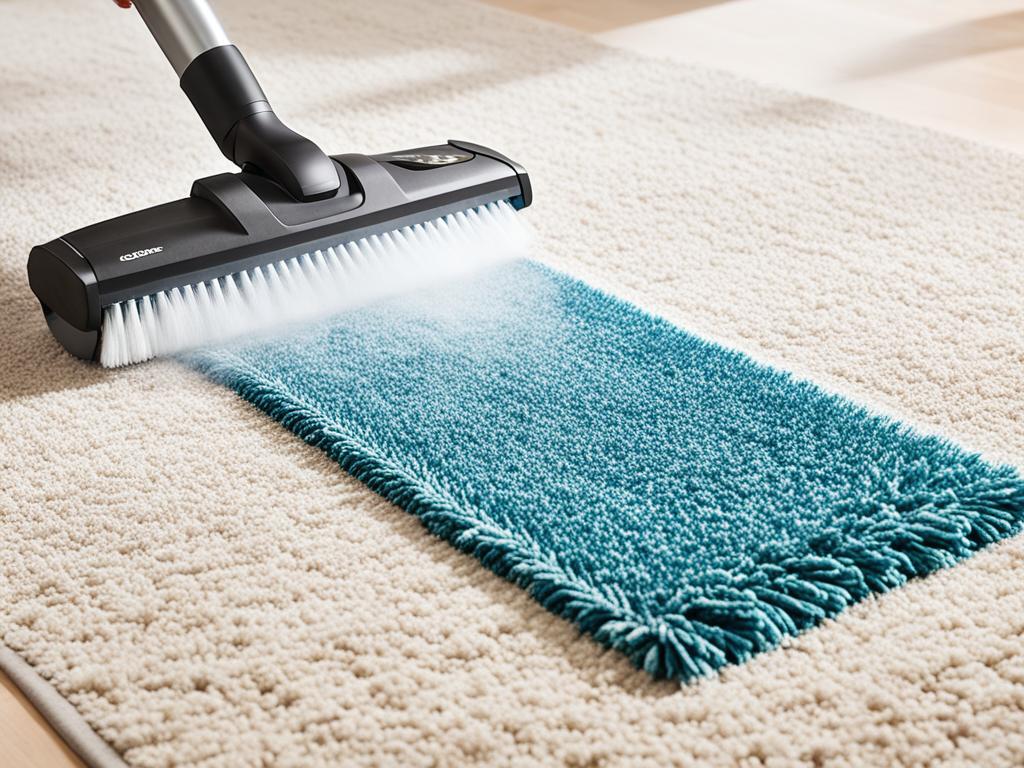
Note: It’s important to avoid using bleach when disinfecting and deodorizing rugs, as bleach can cause stains and damage the rug fibers.
If you have a natural material rug or an antique rug, it’s best to consult a professional rug cleaner for disinfection and deodorization. Their expertise in handling delicate and valuable rugs will ensure the best results. Professional rug cleaners have the necessary tools and solutions to safely and effectively disinfect and deodorize rugs of all types.
By disinfecting and deodorizing your rug, you can ensure a clean and fresh environment in your home, free from harmful bacteria and unpleasant odors.
Overview of Pressure Washing a Rug
Pressure washing a rug can be an effective cleaning technique to revitalize its appearance. However, it’s crucial to follow proper pre-cleaning preparation and drying methods to ensure optimal results and prevent mold and mildew growth. Here is an overview of pressure washing a rug and the key steps to follow:
Pre-Cleaning Preparation
Before pressure washing a rug, it’s important to prepare the rug and the washing equipment:
- Clear the area: Remove any furniture or objects from the rug to create a clear working space.
- Ventilate the area: Ensure proper ventilation to allow for a quick drying process.
- Choose appropriate detergents: Select mild detergents suitable for the rug’s fabric type and any specific stains or dirt present.
- Inspect the rug: Check for any damages or loose threads. Repair or address these issues before proceeding with the pressure washing.
- Protect delicate areas: Cover any delicate or sensitive components, such as fringes or decorative elements, to prevent damage during the pressure washing process.
Pressure Washing Techniques
When using a pressure washer to clean a rug, it’s essential to apply the right techniques to safeguard the rug’s integrity:
- Avoid high-pressure settings: Use a lower pressure setting to prevent potential damage to the rug fibers or fabric.
- Work from outside to inside: Start cleaning from the outer edges of the rug and gradually move towards the center. This approach prevents the spreading of dirt or stains.
- Keep a consistent distance: Maintain a consistent distance between the pressure washer nozzle and the rug surface to ensure even cleaning without over-saturating the fibers.
- Use gentle sweeping motions: Move the pressure washer wand in gentle, sweeping motions to evenly distribute the cleaning solution and remove dirt effectively.
Drying the Rug
Properly drying the rug after pressure washing is crucial to prevent moisture-related issues and maintain its condition:
- Air drying outside: Hang the pressure-washed rug in a well-ventilated area outdoors, preferably in a shaded spot to avoid direct sunlight exposure.
- Indoor drying rack: If outdoor drying is not feasible, use an indoor drying rack with proper airflow to promote efficient drying.
- Towel blotting: Gently press clean towels against the rug’s surface to absorb excess moisture.
- Using a wet-dry vacuum: Run a wet-dry vacuum over the rug to remove additional water and speed up the drying process.
- Dehumidifier: In high-humidity environments, utilize a dehumidifier to help reduce moisture levels and hasten the drying process.
Remember, pressure washing a rug can be complicated and requires proper equipment and expertise. If you’re unsure or dealing with delicate or valuable rugs, it’s recommended to consult a professional cleaning service. They can offer specialized knowledge, equipment, and ensure the best cleaning outcome for your rug.
Techniques for Effective Cleaning
When pressure washing a rug, it’s essential to utilize proper techniques to ensure thorough and safe cleaning. This section will outline key techniques to achieve effective results.
1. Avoid using high-pressure settings:
To prevent damage to delicate fabrics, it’s crucial to avoid using high-pressure settings when pressure washing rugs. High-pressure settings can cause fibers to unravel or fray, leading to irreversible damage. Instead, opt for lower pressure settings to maintain the integrity of the rug.
2. Work from outside to inside:
When dealing with tough stains or heavily soiled areas, it’s best to start cleaning from the outside and work towards the center. This method prevents the spreading of dirt or stains, ensuring a more controlled and efficient cleaning process. By gradually moving from the outer edges towards the center, you can achieve a more thorough clean without causing further damage.
3. Consider professional cleaning services:
In some cases, pressure washing delicate or valuable rugs on your own may pose risks. If you’re dealing with antique rugs or rugs with intricate designs, it’s wise to consider hiring professional cleaning services. Professionals have the expertise and specialized equipment to handle delicate materials and implement appropriate cleaning techniques. They can also offer customized treatments to address specific rug cleaning needs.
By following these techniques, you can effectively clean your rugs using pressure washing methods while minimizing potential risks and maximizing results.
Proper techniques are crucial when pressure washing rugs to ensure thorough cleaning without causing damage. Avoid using high-pressure settings, work from outside to inside, and consider professional cleaning services for delicate or valuable rugs.” – Rug Cleaning Experts
Drying Methods for Rugs After Pressure Washing
After pressure washing a rug, it is crucial to ensure proper drying to prevent moisture-related issues. Here are some effective drying methods for pressure washed rugs:
- Air drying outside: One of the simplest and most effective methods is to hang the pressure washed rug outdoors. Find a suitable spot, such as a clothesline or a sturdy outdoor rack. Ensure that the rug is evenly spread out and allow it to dry naturally in the fresh air. Avoid direct sunlight, as it can fade the colors or damage the rug fibers.
- Indoor drying rack: If outdoor drying is not feasible, consider using an indoor drying rack. These racks are designed to provide optimal airflow to aid in drying. Simply place the pressure washed rug on the rack, making sure it is well-supported and not folded or crumpled. Allow sufficient time for the rug to air dry completely.
- Towel blotting: Before hanging or placing the rug for drying, use clean, absorbent towels to blot out any excess moisture. Gently press the towels onto the rug surface to soak up the water. Repeat the process with dry towels until no more water can be absorbed.
- Using a wet-dry vacuum: If the rug is heavily saturated, a wet-dry vacuum can be a helpful tool. Use the vacuum to suction out the water from the rug, working in a systematic manner across the entire surface. Take care not to apply excessive pressure that may damage the rug.
- Dehumidifier: In humid climates or during wet weather, using a dehumidifier in the room can aid in the drying process. The dehumidifier helps to remove excess moisture from the air, expediting the drying time for the rug. Ensure proper ventilation in the room to enhance the effectiveness of the dehumidifier.
By employing these drying methods, you can ensure that your pressure washed rug dries thoroughly, reducing the risk of mold, mildew, and unwanted odors.
Conclusion
Drying an area rug efficiently is crucial for preserving its quality and preventing moisture-related issues. Whether you have a delicate or valuable rug, professional rug cleaning and drying services can ensure the best results. By entrusting your rugs to experts, you can rest assured that they will receive the proper care and attention they deserve.
However, proper rug maintenance is also essential in keeping your rugs clean and beautiful in between professional cleanings. Regular cleaning and following proper drying techniques are key. Remember to remove excess water, utilize effective rug drying methods, disinfect and deodorize as needed, and avoid harsh chemicals like bleach.
By incorporating these practices into your rug care routine, you can extend the lifespan of your rugs, preserve their quality, and enjoy their beauty for years to come. Whether you choose to DIY or seek professional assistance, the key is to prioritize proper rug maintenance and ensure that they receive the care they deserve.
